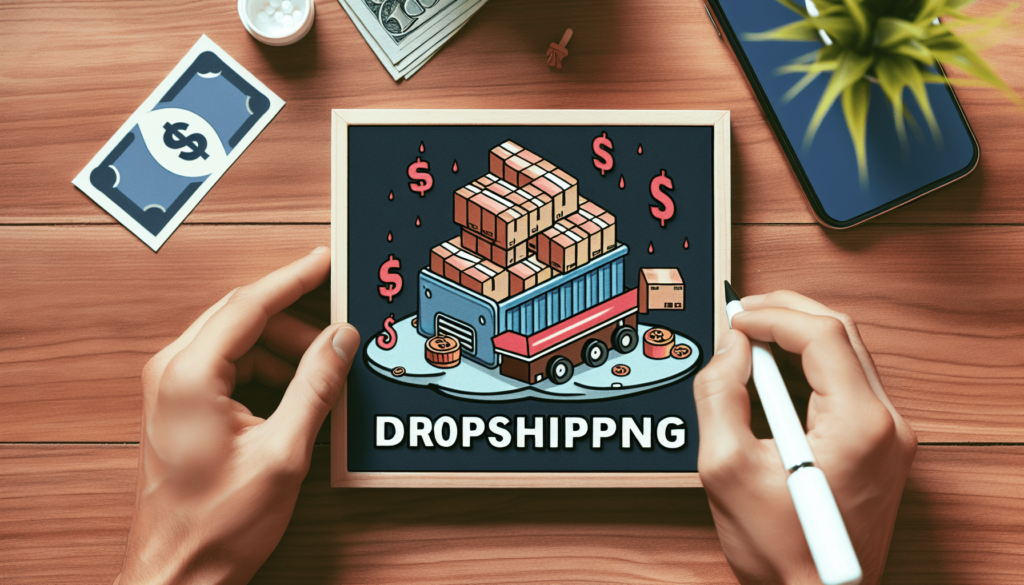Curious about how to start earning with dropshipping? Look no further! In this article, we will cover all the essential information you need to know to embark on a profitable dropshipping journey. Discover how to innovate, connect, and capitalize on the opportunities presented by dropshipping. Whether you’re a seasoned entrepreneur or just starting out, BackersHub.com is here to guide you through the exciting world of dropshipping and show you how to turn possibilities into profitability.

Unlock Earning Power: My $7 Mega Link Secret Revealed!
Understanding Dropshipping
Dropshipping is a business model that allows individuals or businesses to sell products without having to hold inventory. Instead, the retailer partners with a supplier who will handle the storage, packaging, and shipping of the products directly to the customer. This means that the retailer does not need to invest in or manage a physical store or warehouse, making dropshipping a cost-effective and low-risk business venture.
How Dropshipping Works
The dropshipping process begins when a customer places an order on the retailer’s online store. Instead of the retailer fulfilling the order themselves, they forward the order details and customer’s shipping information to the supplier. The supplier then packages and ships the product directly to the customer. In this way, the retailer never sees or handles the actual product.
Life-Changing: How a Simple Link Brought Me Financial Freedom!
Benefits of Dropshipping
There are several advantages to choosing dropshipping as a business model. Firstly, it requires minimal upfront investment since there is no need to purchase inventory in advance. This means that retailers can start their business with lower risk and reduced financial burden. Additionally, dropshipping allows for greater flexibility as retailers can easily add or remove products from their online store without the constraints of physical inventory. Finally, dropshipping offers scalability and the potential for high-profit margins as retailers can focus on marketing and sales while the supplier takes care of order fulfillment.
Choosing the Right Products
Identifying profitable product niches is crucial for success in dropshipping. Retailers should research current trends and analyze market demand to identify products that have a high potential for sales. Additionally, considering the competition is important to ensure that the chosen niche is not oversaturated. Retailers should look for products that have a reasonable level of competition but still offer a unique selling proposition.
Once a profitable product niche is identified, finding reliable suppliers is key. Retailers should look for suppliers who offer competitive pricing, quality products, and reliable shipping and customer service. It is advisable to contact and establish relationships with multiple suppliers to ensure a steady supply of products and mitigate any potential risks.

Daily Payday From Your Couch? Try now for the cost of a cup of coffee!
Setting Up an Online Store
Selecting the right e-commerce platform is essential for creating a successful dropshipping business. Retailers should consider factors such as ease of use, available features, customization options, and compatibility with their intended payment gateways. Popular e-commerce platforms like Shopify, WooCommerce, and BigCommerce offer user-friendly interfaces and a wide range of integrations to streamline the management of an online store.
Designing a user-friendly website is vital to attract and retain customers. Retailers should aim for a clean and organized layout, easy navigation, and smooth checkout process. It is important to optimize the website for both desktop and mobile devices to ensure a seamless shopping experience across different platforms.
Optimizing product listings is another crucial aspect of setting up an online store. Retailers should write compelling product descriptions, include high-quality images, and provide detailed specifications to help customers make informed purchasing decisions. Implementing search engine optimization (SEO) techniques such as incorporating relevant keywords and meta tags will also improve the visibility of the online store in search engine results.
Managing Inventory and Fulfillment
Finding an Inventory Management System (IMS) is essential for efficient inventory management in dropshipping. An IMS allows retailers to monitor stock levels and track sales, ensuring that products are always available to customers. Retailers should look for an IMS that integrates seamlessly with their chosen e-commerce platform and provides real-time data updates.
Automating the order fulfillment process is crucial in dropshipping to save time and reduce errors. Retailers can use apps or plugins to automatically forward order details to suppliers and include customized packing slips or invoices. This automation ensures a smooth and streamlined fulfillment process.
Dealing with returns and customer inquiries is an important aspect of customer service in dropshipping. Retailers should establish clear policies regarding returns and exchanges and communicate these policies to customers. It is essential to promptly respond to customer inquiries and provide efficient solutions to any issues that may arise.
Shocking! This one link can pay you time and time again!
Implementing Effective Marketing Strategies
Creating a brand identity is crucial for success in dropshipping. This involves establishing a unique and recognizable brand name, logo, and messaging that resonates with the target audience. Retailers should consider their target demographic and develop a brand that aligns with their preferences and values.
Utilizing social media for promotion is a cost-effective and powerful marketing strategy in dropshipping. Retailers should identify the social media platforms that are popular among their target audience and create engaging content to attract potential customers. Regularly posting product updates, promotions, and engaging with followers can help build brand awareness and drive traffic to the online store.
Running targeted advertising campaigns is another effective marketing strategy in dropshipping. Retailers can utilize platforms like Google Ads, Facebook Ads, or influencer marketing to reach a wider audience and drive targeted traffic to their online store. It is important to carefully plan and analyze the performance of advertising campaigns to optimize results and maximize return on investment.
Providing Excellent Customer Service
Building trust and credibility is crucial in dropshipping as customers rely on the retailer to deliver quality products and provide reliable service. Retailers should prioritize customer satisfaction and aim to exceed expectations in all interactions. This can be achieved by offering prompt and personalized communication, delivering products on time, and resolving any issues or concerns that customers may have.
Establishing clear communication channels is vital for effective customer service. Retailers should provide multiple channels for customers to reach out, such as email, live chat, or phone support. It is important to respond promptly to customer inquiries and provide knowledgeable and helpful assistance.
Resolving customer issues promptly is crucial for maintaining a positive reputation in dropshipping. Retailers should have a clear process in place for handling returns, exchanges, or any other customer concerns. Resolving issues in a timely and satisfactory manner will not only retain the customer but also potentially turn them into loyal advocates for the brand.
Unlock Earning Power: My $7 Mega Link Secret Revealed!
Analyzing and Improving Performance
Tracking key performance indicators (KPIs) is essential for measuring the success and progress of a dropshipping business. Retailers should regularly analyze metrics such as sales conversion rates, average order value, website traffic, and customer acquisition cost. This data helps identify areas of improvement and guide strategic decision-making.
Optimizing conversion rates and sales is a continuous process in dropshipping. Retailers should regularly test and refine product listings, website design elements, pricing strategies, and marketing campaigns to maximize conversions. Implementing A/B testing and analyzing performance data can help identify the most effective strategies and tactics.
Testing and refining marketing strategies is another important aspect of improving performance in dropshipping. Retailers should experiment with different advertising platforms, target audiences, ad formats, and messaging to identify the most effective combination. Analyzing the results and making data-driven adjustments will help optimize marketing efforts and drive better results.
Legal and Financial Considerations
Registering the dropshipping business is necessary to operate legally and establish the business’s identity. Retailers should research the requirements in their jurisdiction and follow the necessary steps for business registration. This typically involves obtaining a business license, registering with tax authorities, and possibly obtaining any required permits.
Understanding tax obligations is crucial in dropshipping to ensure compliance with applicable regulations. Retailers should consult with a tax professional or accountant to determine their tax obligations, including sales tax and income tax. It is essential to accurately track and report sales and income to avoid any legal issues or penalties.
Securing appropriate licenses and permits may be necessary depending on the products being sold in dropshipping. Some product categories, such as alcohol, firearms, or medical devices, may require specific licenses or permits to sell legally. Retailers should research the regulations in their jurisdiction and obtain any necessary licenses or permits to avoid legal complications.
Life-Changing: How a Simple Link Brought Me Financial Freedom!
Ensuring Cybersecurity and Data Privacy
Protecting customer information is a top priority in dropshipping to maintain trust and protect against potential breaches. Retailers should implement security measures such as SSL certificates on their website to encrypt customer data during online transactions. It is important to safeguard customer information and only collect the necessary data required to fulfill orders.
Implementing secure payment methods is crucial in dropshipping to ensure the safety of customer financial information. Retailers should offer reputable and secure payment gateways that are trusted by customers, such as PayPal or Stripe. Encrypting customer payment information and regularly updating security measures will help safeguard against potential cyber threats.
Maintaining website security is essential to protect against hacking or data breaches. Retailers should regularly update and patch their website’s software, use strong and unique passwords, and implement firewalls and other security measures. Monitoring the website for any suspicious activity and promptly addressing any security concerns will help ensure a secure online shopping environment.
Adapting to Market Changes and Trends
Staying updated with industry developments is crucial in dropshipping to remain competitive and adapt to changing market trends. Retailers should regularly research industry news, attend trade shows or webinars, and join relevant communities or forums to stay informed about the latest developments. This knowledge can help identify emerging trends and give insight into consumer preferences.
Monitoring market trends and consumer behavior is vital in dropshipping to anticipate customer demand and adjust product offerings accordingly. Retailers should analyze sales data, customer feedback, and online research to identify patterns or shifts in consumer preferences. This information can guide product selection and marketing strategies to align with current market trends.
Continuously evolving product offerings is essential to stay relevant and meet the evolving needs of customers. Retailers should regularly assess and update their product selection based on market trends, customer feedback, and competitor analysis. Introducing new products or variations of existing products can help attract and retain customers, driving sustainable growth in dropshipping.
Daily Payday From Your Couch? Try now for the cost of a cup of coffee!

